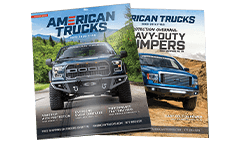Guaranteed 12/24 Delivery Still Available see item page for details! available on most items - Details
Body Kits Tech Center
Spoilers: Enhancing the Look and Performance of Your Vehicle
Spoilers are a matter of personal taste. Some people can live without them, others swear by their low-flying looks. There's no denying, though, a well-placed spoiler or wing makes your vehicle look considerably faster.
How would a spoiler or wing work for my vehicle?
There's a host of benefits to picking one of AmericanTrucks's spoilers or wings, including:
- Instant sporty looks for any vehicle
- The choice between shapes and styles to fit your vehicle's looks
- Optional precision paint matching for spoilers
- Straightforward installation that's simple for the do-it-yourselfer
Spoiler basics: how they work and where they came from
Spoilers were first developed as an ingenious creation appearing on race Ferraris in 1961. These top-end sports cars, born for ridiculous speed, needed some help staying tight in turns without adding weight.
The problem facing these Ferraris continues today with other racers. They must be as light as possible for maximizing acceleration and speed. At these high speeds, though, the back end of the car tends to get "loose" — especially in turns. That's because the car isn't sticking to the track well, thanks to excess lift.
One way to combat lift is to add weight to the car, which creates the extra downforce needed to keep the back end from being too loose. Weight, though, is an enemy of speed. And, in turns, the momentum of the extra weight means the driver must fight against its inertia.
Adding a spoiler to the car was the ideal solution to creating extra downforce on the vehicle without extra weight. A spoiler changes the aerodynamics of a vehicle, disrupting the airflow over the car. The disruption adds more downward pressure to the back end, tightening turns and reducing hazardous lift.
There's a catch to the spoiler design. Disrupting the airflow over the vehicle increases drag, thus reducing speed. Getting the right mix of downforce and reduced drag is an art form, leading to many shape and style changes to race cars. Most top-speed racers have adjustable spoilers for tweaking the balance of lift and drag to an optimum mix that maximizes speed without exceedingly dangerous handling. It's just one of the many adjustments racers of all level make in time trials and practice laps.
A guide to the sporty looks of a spoiler
As spoilers and wings became more popular with top-end street and race cars, they became synonymous with speed. Automakers began incorporating spoilers into their production cars soon after. Some spoilers like those used by European sports car outfits such as Porsche were implemented as a means of stabilizing the vehicle on the limitless autobahn and wide-open backroads. Current models, like Audi's TT, use a low profile fin that's necessary for back-end stability because of the lightweight design and powerful engine.
The vast majority of spoilers used on showroom cars today are just for decoration, that's it and that's all. They have no measurable effect on aerodynamics or vehicle stability. They do, however, accentuate the sporty lines and speedy looks of modern sedans. Most car buyers pick a spoiler for tacking-on an extra 20mph to their vehicle's looks.
Quick reference to spoiler shapes and styles
With the sport-compact modification movement of the late 90s/early 00s, crazy spoiler and wing design was king among street racers and laser-tag VIPs. Super tall spoilers, multi-level models, and gigantic wings sat on back of the Integras, Accords, and Eclipses of the day. Many of these odd designs were actually homemade spoilers, and didn't come close to resembling a manufacturer part.
More modern factory-style spoilers sit much lower than these fast and furious homemade mods; some hardly rise above the trunk lid. The lower these spoilers sit, the less effect they tend to have on downforce and stability. Likewise, they don't create any extra drag. And, if they have a flat top deck, there's a good chance they have no effect on anything but appearance.
Quick guide: spoiler styles
AmericanTrucks offers two styles: factory-style spoilers for sporty lines, and aggressive-looking wings. One is just for decoration; the other can have a legitimate effect on the handling of your vehicle at high speed.
Factory-style spoilers:
Factory-style spoilers are designed to mimic the look of spoilers sold on sport models of your vehicle, which are made for accentuating curves and sporty looks. In many cases, they curve flush with the trunk lid for a near-seamless appearance. And, as a bonus, these spoilers are equipped with an extra taillight when the original factory spoiler of the same make employed a light.
Spoiler advice: custom paint
AmericanTrucks's factory-style spoilers can be ordered paint-matched to your vehicle's original color. As auto finishes will naturally fade over time, ordering a paint-matched option for a vehicle more than 3-years old is not recommended. Instead, order the spoiler primed to paint, and have a local shop do a more precise color match.
Factory-style spoilers from AmericanTrucks boast a hand-crafted fiberglass construction for durability, smoothness, and consistency with the manufacturer's original design. These spoilers can be ordered with a custom paint job that matches your vehicle's original color. The process involves expert application of multi-layer automotive-grade paint and the appropriate clear coat finishes.
Wings:
Sitting taller than a factory-style spoiler, car wings can grab a little more of the air passing by your vehicle. The wider, angled design also does more to redirect wind resistance and generate downforce.
All of AmericanTrucks's car wings are crafted from lightweight aircraft-grade aluminum. It's the ideal material for combining durability with a product that won't weigh your back end down. And, a few of the models feature a two-deck design that allows you to tune the effect of your spoiler accurately to the speeds you most frequently drive.
Installation
Mounting your factory-style spoiler or car wing to your vehicle can be slightly tricky. It's not as easy as throwing in a new set of floor mats or attaching seatbelt pads, but it's easier than replacing an exhaust system.
Special care is needed for marking and lining up the spots where you'll need to drill holes in the trunk lid. Be sure to set aside plenty of time to do the job with care and precision. All necessary mounting screws and gaskets are included with your spoiler or wing. Installation shouldn't be difficult for the experienced do-it-yourselfer or rabid gearhead. If you're not sure what a drill is or become squeamish about boring through your vehicle's trunk lid, consider having a pro install the spoiler or car wing.
Which spoiler or wing is right for my vehicle?
Picking the right spoiler or car wing for your vehicle depends on the personality of your ride. Consider the following when trying to select the right one:
- Which is more important to you: looks or function
- Whether a factory-style spoiler or car wing model would look best on your vehicle
Which is more important for my vehicle: looks or function?
Spoilers and wings have two distinctly different appearances and functions. Wings sit high enough to make a difference in aerodynamics, while factory-style spoilers have little or no effect on downforce (though they won't increase drag, either).
When looks are the most important factor for your vehicle, pick a factory-style spoiler like the Elite Spoiler.
If you drive your vehicle at exceedingly high speeds and/or track race with it on the weekends, a wing (like the Warbird Car Wing by Lund) will give you some extra downforce and stability. The best aerodynamic effect is gained by getting a car wing with adjustable decks and tuning the deck angle to match your driving pattern. The Lund Double Eagle Car Wing has this capability.
Would a wing or a spoiler look best on my vehicle?
Choosing between a wing and a spoiler depends on where you want to take the looks of your vehicle. Factory-style spoilers most closely resemble the original part for your vehicle, while wings bring the appearance of a formula-1 race spoiler in a more modern shape (and minus the huge Marlboro logo). Spoilers can be paint-matched to your finish; wings cannot.
If you want a seamless look that fits your vehicle's stock appearance, pick a factory-style spoiler like the UCI Factory Spoiler.
For custom color-matched style, a factory-style spoiler is the right way to go. Pick a car wing for high-tech, modified sport compact looks (see the Hawk Car Spoiler by Lund).
Great moments in spoiler history: U.S.A.
In 1965, driver Sam McQuagg lined up in the blocks with the first-ever spoiler used in a NASCAR Grand National Series race, and took the checkered flag at the Firecracker 400 run at Daytona International Speedway. The diminutive 1.5" spoiler made a big difference on the back end of his '66 Dodge Charger Fastback - a design modification made by engineers who noticed their latest race car tended to lift at high speeds. It was McQuagg's only win, but it had a tremendous impact on stock car racing and automotive design.
Race truck wings:
Today, NASCAR uses regulations on spoiler size and shape to balance competition, with different parameters for every track. Drivers say that spoiler regulations subtract too much downforce, making their cars too loose in the turns and difficult to keep off the walls.
Years after McQuagg's victory, the signature Dodge Daytona look was minted with a towering wing addition that became an instant classic. This distinct Daytona spoiler made its return to dealership lots in 2005 as a concept sub-model of the Dodge Ram full-size truck. The rear spoiler, much shorter than the original, sits just above the tailgate - a sign that the automakers are catching on to the growing trend of truck spoilers installed to the stake pockets or mounted to a hard tonneau cover.

